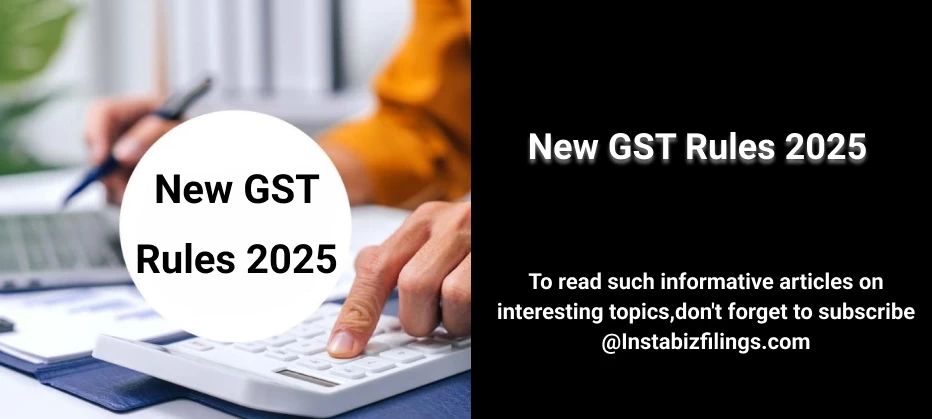
New GST rules 2025
July 3, 2025 by Team Instabizfilings
In India, the system of the Goods and Services Tax (GST) is the subject of regular changes because the government is interested in simplifying the tax system and improving the efficiency of revenue collection. Until 2025, a couple of noteworthy updates and proposed changes exist, which ought to be noted by the businesses, professionals, and taxpayers. The details of the New GST Rules 2025 are shared below as follows:
Multi‑Factor Authentication (MFA) on GST Portal
-
Effective Dates: Effective April 1, 2025, all taxpayers—regardless of their reliance on Annual Aggregate Turnover (AATO)—are required to use Multi-Factor Authentication (MFA) in order to file their tax returns (source: cagpt.in).
-
Why It Matters: Enhances the integrity of data, reduces chances of fraud and enforces login integrity.
-
Actions: Revise mobile numbers/email, user training and readiness of OTP/2FA.
E‑Way Bill & Shipping Controls
-
New Restrictions:
- Any base document, which is older than 180 days, counting back its age since the invoice date should not be subject to e-way bill.
- The e-way bills are only maximum as extension of 360 days after the issue of the e-way bills.
-
Impacts:
- Cards back-dating enhances compliance logistics.
-
Actions:
- Introduce checks in logistics programs and monitor the authenticity of the documents.
E‑Invoice Reporting Tightened
-
From April 1, 2025:
- For businesses whose AATO is 10 crore (as compared to previously 100 crore) will have to do mandatory IRP (Invoice Registration Portal) reporting within 30 days of the date of the invoice.
- Credit notes have now been included under IRP e-invoicing.
-
Why:
- In order to prevent late/ fake invoices and prevent bogus ITC claims.
-
Actions:
- Put in place upgraded billing systems to alert on delays and submit the IRP in good time.
Mandatory Input Service Distributor (ISD) Setup
-
Effective April 1, 2025: The firms having more than one GST registration with a single PAN should apply and submit GSTR-6 under the ISD normal mechanism of taxes redistribution.
-
Why: Inter-unit credit distribution is standardised, and transparency is improved.
-
Actions: Enrol into ISD and define official procedures of assigning credits.
Form Revisions: GSTR‑7 & GSTR‑8
-
From Feb 11, 2025: New formats demanded wider details at the invoice level including GSTIN (GST Identification Number), invoice identification, amounts of the transactions, and tax deducted/collected.
-
Why: Enhances TDS/TCS matching and accuracy.
-
Actions: Refresh data capture template and software reporting logic.
GSTR‑3B Lockdown Starting July 2025
-
As soon as submitted, GSTR‑3B will be forever frozen every month; the corrections can be made only through GSTR‑1A.
-
Impact: It minimises errors that are committed after the filing has been made and augments the dependability of the data.
-
Actions: Reconcile the GSTR‑1A before filing 3B; pre‑file, then double-check.
Time-bar for Late Filings: 3-Year Sunset
-
As of July 1, 2025, three years after the due date, taxpayers will no longer be allowed to file or amend returns that are older than that.
-
Why: It streamlined the compliance window and eliminated old loopholes in filing.
-
Actions: Any late returns should be filed before the cut off date; books should be reconciled, FY 2022 23 and onwards.
Sector-Specific Rate & Exemption Updates
-
Green Hydrogen: Green energy investment could be stimulated by a cut in GST on clean energy from 18 to 5 per cent.
-
Leather, Watches & More: Leather, watches and more, you might mention electronics, medical devices, life-saving drugs, online gaming etc.
-
Gene Therapy is free of charge, and strengthened rice has a 5 per cent GST since Jan 16, 2025.
-
Note: The rates of the changes are dynamic: One should always look at the official GST council notifications.
Ease in GST Appeal Filing
-
Recently, the Supreme Court permitted the use of Input Tax Credit on pre-deposit in GST appeals- a move which is likely to relieve the stress on the cash flow.
-
Actions: Keep a watch on the GSTN direction feedback on claim processing and submission procedure.
Action Plan for Businesses
-
Introduction of MFA access to all GST users.
-
Revise the ERP/e-way bill software to limit the generation of e-ways to specific dates.
-
Thirty-day window sync-up e-inv vs IRP; credit note processing.
-
Enrol and incorporate the ISD mechanism in multi-unit coordination.
-
Billing systems should be updated to comply with GSTR‑7 / brought up to date with GSTR‑8.
-
Improve on internal controls in order to complete GSTR-3B properly before filing.
-
But as we get into FY 2022- 23 and following, the returns have to be filed and reconciled with the July deadline.
-
Monitor rate notifications by industry at the GST council meetings.
-
Install mechanisms relating to the use of ICT in pre-deposits in appeals.
Conclusion
The 2025 GST amendments will be targeted to strengthen compliance, enhance data integrity, and lock down on digital transactions. To make your way through this:
-
Be abreast with GST Council announcements,
-
Match up systems soon with new processes.
-
Consulting a professional for all changes to the rates sector-specific.
Disclaimer
The information provided in this blog is purely for general informational purposes only. While every effort has been made to ensure the accuracy, reliability and completeness of the content presented, we make no representations or warranties of any kind, express or implied, for the same.
We expressly disclaim any and all liability for any loss, damage or injury arising from or in connection with the use of or reliance on this information. This includes, but is not limited to, any direct, indirect, incidental, consequential or punitive damage.
Further, we reserve the right to make changes to the content at any time without prior notice. For specific advice tailored to your situation, we request you to get in touch with us.


